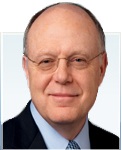 |
| Pfizer CEO Ian Read |
The agreement's been made: The boards at Pfizer ($PFE) and Allergan ($AGN) have ratified a megamerger--worth about $160 billion--that will create the world's biggest pharma company and send Pfizer overseas, the companies announced on Monday.
At, $363.63 a share, the value of the deal is a little greater than where reports pegged it last week, and there are a couple of twists. For one, the terms include a cash component of between $6 billion and $12 billion, in addition to 11.3 Pfizer shares for every Allergan share, the companies said. And for two, Allergan CEO Brent Saunders won't be taking the reins from Pfizer's current skipper Ian Read--a move sources last week told Forbes would be a requirement for any friendly tie-up with the Irish pharma.
Instead, Saunders--who has risen quickly through pharma's leadership ranks over the past few years--will serve as Read's right-hand man, bearing the titles of president and chief operating officer. He'll also grab a seat on the combined company's board, as will Allergan chairman Paul Bisaro, who vacated the CEO roll at the company for Saunders when it bought Forest Labs as Actavis last year. Two other Allergan directors who haven't yet been selected will be joining the combined company's board, too.
 |
| Allergan CEO Brent Saunders |
Meanwhile, the deal will bring Pfizer what it's been wanting for quite some time now: a tax inversion. Pfizer estimates that the transaction will sink its tax rate--currently the highest in Big Pharma at about 25%, according to Evercore ISI--to about 17% to 18% within a year after the deal's close. And to help ensure it does, the companies will technically structure the deal as a reverse merger, with the smaller Allergan buying Pfizer.
Of course, there may be some obstacles in the way of closing the buyout. Last week, the Treasury Department released new rules aimed at putting a stop to tax inversions, though they "do not seem to materially impact" the Pfizer-Allergan hook-up, Bernstein analyst Tim Anderson wrote in a recent note to clients. There's still a risk of government action, though, The Wall Street Journal points out, and the companies will also have to secure antitrust approval from regulators around the globe.
And if they do pull it off? The industry will witness the combination of two companies that raked in more than $60 billion in combined sales last year. Pfizer and Allergan expect the new company to generate annual operating cash flow of more than $25 billion starting in 2018, and they're forecasting an EPS boost of more than 10% for the following year.
But the new company--set to take on Pfizer's moniker--likely won't stick together as one pharma giant for long. Industry-watchers expect the merger to speed along Read's plans for a large-scale split up, which would see the company break into two pieces: One focused on drugs that are at or near the end of their patent lives, and one focused on products with more IP protection.
It's not the first M&A move Pfizer's made to gear up for that potentiality, either. In September, it closed a $15 billion buyout of Illinois-based Hospira to bolster its established products business, beefing up in biosimilars and sterile injectables.
- here's the announcement
- read the WSJ story (sub. req.)
Special Reports: The top 15 pharma companies by 2014 revenue - Pfizer | Pharma's top 10 M&A deals of 2014 - Actavis/Allergan - Actavis/Forest Laboratories | The 25 most influential people in biopharma in 2015 - Brent Saunders - Actavis